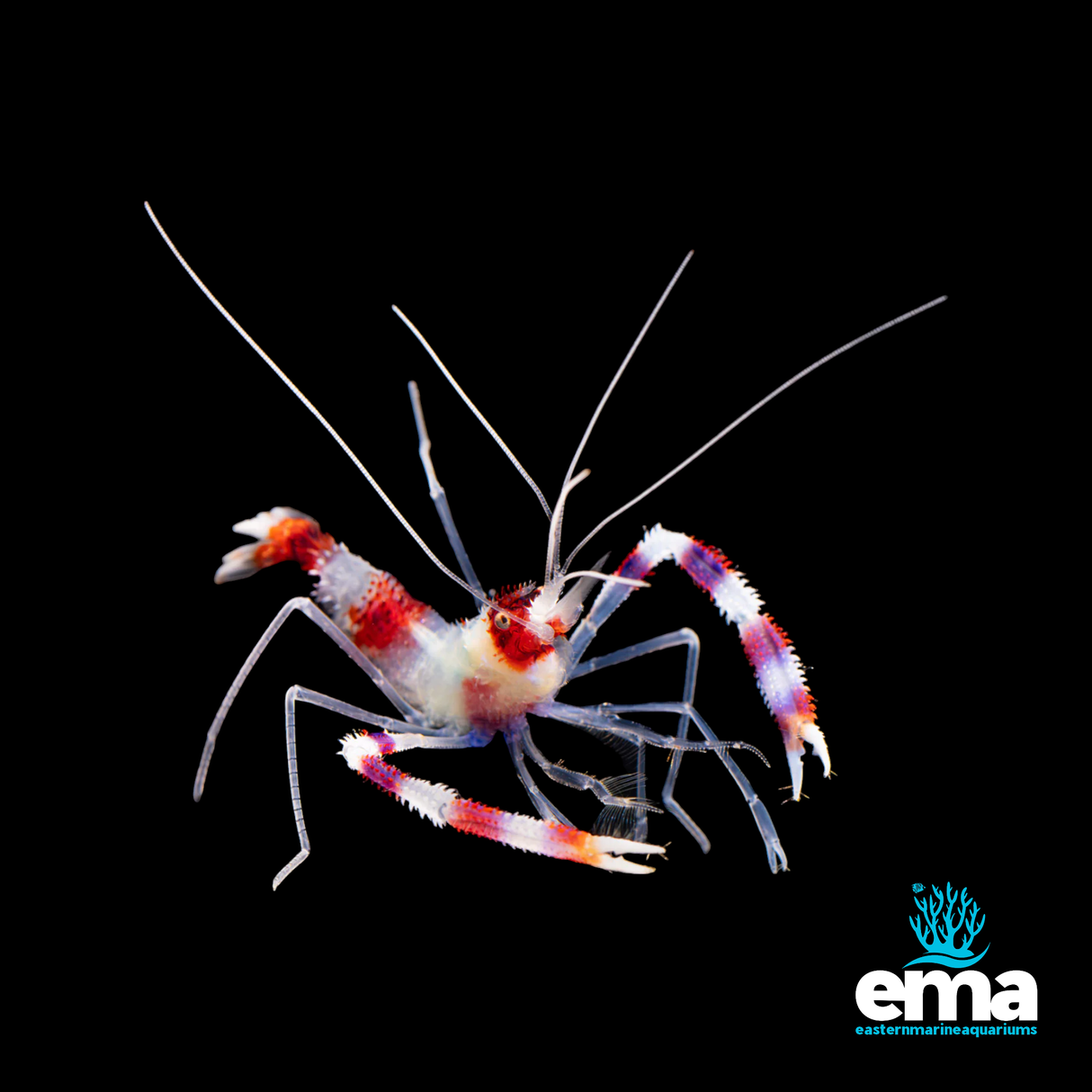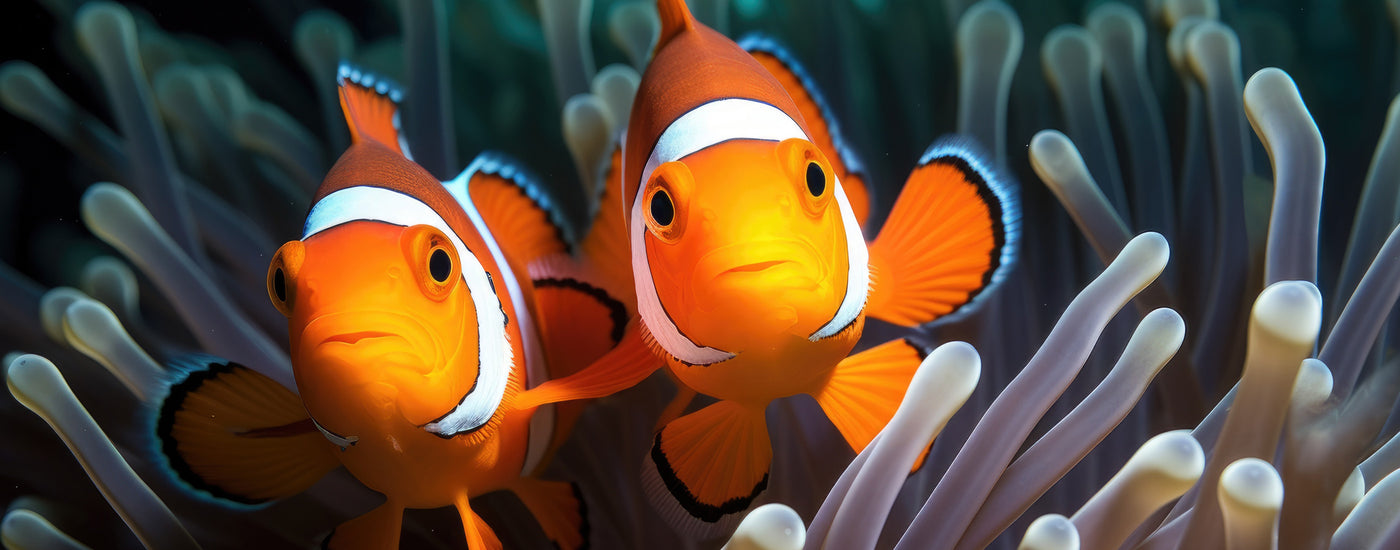Banded Coral Shrimp
Banded Coral Shrimp - Small is backordered and will ship once an order is placed. Contact us for delivery timeframes.
Couldn't load pickup availability
Delivery and Shipping
Delivery and Shipping
We highly advise same day airfreight for all fish shipping, although overnight courier is also available nationwide.
- Airfreight is a flat $75 rate anywhere in NZ and can include up to 10 fish/coral for the single charge. We can also include dry goods/frozen food in the order, up to a total weight of 75kg.
- Overnight courier is $25-50 depending on the destination and polybox used.
For more information on shipping, head to our shipping page!
What we're feeding
What we're feeding
Nutrition, like humans, is important for fish. You get out what you put in. Therefore, EMA places great emphasis on providing all our fish a varied diet. Below is an example of what our fish are currently feeding on:
- Fauna Marin Soft Multi Mix
- Fauna Marin Veggie Flakes
- Frozen Nutrition Mysis
- Frozen Nutrition Formula One
- Frozen Nutrition Formula Two
- Live Brine Shrimp
- Fauna Marin 100% Natural Green Seaweed
- Cockles (Mainly for butterflies/angels, available from your local supermarket).
All our staff are trained in fish nutrition, so if you require any guidence, please ask! Frozen/Dry food can also be sent with your airfreight consignment with no extra charge, so add these to the order if you wish and we will combine them into a seperate box.
Acclimation tips
Acclimation tips
Adjusting to a new aquarium is the most stressful event a fish can go through, so it's important to understand the following for long term success:
- Consider your existing fish. When adding a new fish, often existing fish can become aggressive to assert their dominance. This can be hard on the new fish, due to the stress of moving aquariums and then dealing with aggressive fish. Consider removing the existing fish using a fish trap (ours is available for loan, just ask) and place any aggressive fish in the sump for a couple of weeks while the new fish adjusts to their new home.
- Always acclimate without any lights on. Bright light can be stressful, especially when a fish has been in transit.
- Slowly open the box to avoid light stress
- Use the float acclimation method and ensure acclimation isn't too long - we recommend up to 30 minutes.
- If a fish is showing signs of stress during acclimation, consider speeding up the acclimation. Remember, stress is the number one killer of fish.
- Once you've adjusted to salinity and temperature through acclimation, release the fish into the aquarium (but not the bag water).
- Give the fish space. Although adding a new fish is an exciting time, remember that the fish is stressed, so give the fish space while he/she settles in. Avoid sudden movements, running around the tank or tapping on the glass.
- Have realistic expectations. It is normal for new fish to take a while to eat, or show natural behaviours. This is a transition period, so the less stress you can place the fish under, the better the long term result.
- Ask. Seems obvious, but our staff can't help if we don't know. Always feel welcome tor each out for advice. You can either use our Chat function 24/7, or email/Facebook us.
EMA's Promise.
Qualified, Honest Advice Using Techniques & Protocols that we use ourselves.
Description
Description
Interestingly, members of the Stenopodidae family are known as "Boxing Shrimp" because of the large pinchers on their third set of legs. These pinchers are often held erect and give the Banded Coral Shrimp the appearance of a boxer ready to fight. Though the Banded Coral Shrimp can be aggressive towards other Banded Coral Shrimp and smaller shrimp of different species, most are peaceful towards fish, corals, and invertebrates within your aquarium. Because of its aggressive disposition towards other Banded Coral Shrimp, the Banded Coral Shrimp should be housed individually or kept as a true mated pair.
Native to the oceans of Indonesia, Stenopus hispidus is perhaps the most widely distributed shrimp in the sea. It usually hangs upside-down in caves or crevices, with only its antennae emerging from the hole. While molting, the Banded Coral Shrimp will often hide from sight for 1-2 days in the rocks of the reef. In the home aquarium, provide sufficient room for the Banded Coral Shrimp so it can move about freely without its long antennae touching neighboring corals or anemones.
The Banded Coral Shrimp is relatively hardy and boasts an aquarium-suited length that rarely exceeds 3 inches, 6 inches with the antennae. The male Banded Coral Shrimp is usually smaller. Breeding the Banded Coral Shrimp is usually not successful. Larvae generally succumb to filtration and skimming.
Like other invertebrates, the Banded Coral Shrimp is intolerant of high nitrate or copper levels. Be sure to maintain proper iodine levels in the aquarium to help ensure proper molting. The Banded Coral Shrimp must be acclimated slowly to avoid any salinity and/or pH shock.
In the wild, the Banded Coral Shrimp is a scavenger. In the home aquarium, it will accept most flaked and frozen foods.
Source: Live Aquaria
Our Quarantine Procedures
Our Quarantine Procedures
We take livestock seriously. That's why we don't sell anything we wouldn't be comfortable putting in our own tank.
As we are direct from source, we import and sell direct to the public. This means you can buy with confidence knowing EMA prides itself on excellent handling and conditioning protocols.
All our fish held in a quarantine system for a minimum of 3 weeks. During this time, regular water changes are performed, and twice daily (or sometimes more) feedings are performed.
Copper is dosed and checked twice a day for ich and velvet.
During this treatment fish are given formalin baths for brooklynella and a minimum of 3 praziquantel doses is performed for flukes.
Payment & Security
We offer a number of different payment methods, including Credit Card, Afterpay, Q Card, Pay at Collection, Bank Transfer and POLi.
Credit card payments are processed securely using the highest possible security protocols.





